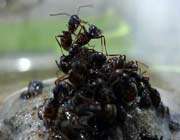Ants can Build Rafts to Escape Floods

Ants can build rafts to escape floods. These are not boats made of wood or leaves, but of fellow ants behaving in a collective structure for the greater good of the nest. During a heavy rain season, people living in flood plains have observed floating ant colonies in what appears to be a raft. Being social creatures, the insects work together to ensure the survival of their colony. Until a recent Swiss study, little was known about the composition, caste system, or the construction of the raft.
When flood waters endanger the nest and there is no way to move across land to a safe location, ants will build a watercraft. They use members of the colony as the raft and float together. The bottom of the craft consists of larvae, pupae, and young worker ants that serve as buoyancy. They are held in place by the mandibles of worker ants that are two to three layers tall. In the center rides the queen surrounded by the older drones that protect her from drowning.
While floating, the ants realign themselves within the raft to withstand the flood waters and other debris crashing against them. Clinging together tarsus to tarsus or mandible to tarsus, the insects secrete an oily fluid known as viscoelasticity that sticks to smooth surfaces, in this case themselves, to help keep their raft afloat and the queen safe.
Dr. Jessica Purcell, an ecologist at the University of Lausanne in Switzerland, led a team of researchers to study how ants survive catastrophes such as a sudden flood. Her team collected colonies of a species known as Formica selysi. These ants are abundant in the Alps and Pyrenees where floods are common during heavy rains. In separate lab experiments held within a controlled area, the queen and her colony were placed on a platform. There were no other means of escape when the water levels began rising.
During the flooding, Purcell’s team noted where the larvae, pupae, workers, and finally the queen positioned themselves upon the raft. Their hypothesis was that when forced to evacuate, the ants would protect their queen and the young, the two most valuable members of the colony. Their reasoning followed a human belief that when a ship at sea is sinking and there is a shortage of lifeboats, women and children receive priority. No such realities apply in the ant world. Only the queen matters.
Another hypothesis
Another hypothesis tested the cost benefits of where the ants positioned themselves. Was it done altruistically or through coercion? Would an ant refuse its assignment and be forced to stay at its raft section by other workers? When given the option of no escape other than forming a raft, no ant resisted its assignment.
The larvae and pupae served as the raft’s keel. Was that for the greater good of the nest or a general benefit of a select group? As Purcell and her team learned, younger members of the nest have more body fat and are better able to float. The researchers noticed that during the experiment, the younger ants and the larvae better resisted submersion. Their positioning offered buoyancy to the most important member of the nest, the queen.
Wood cylinders were introduced in some experiments and sometimes implemented into the raft. However, most ants preferred using their own kind as construction material.
High survival rate among worker ants and larvae indicated that being placed at the bottom of the raft is not as dangerous as earlier believed. The mortality rates of the nests in the experiment remained low. Even without the presence of a queen or larvae, worker ants formed rafts.
Upon reaching dry ground, workers at the top layers disembarked first. Submerged ants required one to three hours to free themselves and begin normal activities.
The experiment proves that like humans, there is a survival instinct among insects. Given the option of drowning, ants can build rafts to escape floods.
Source: G Liberty Voice
Other links:
Fact of the Day: Whales
Fact of the Day: First sharks
Fact of the Day: Pink Dolphins